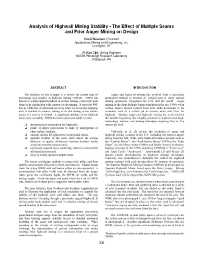Mining Publication: Analysis of Highwall Mining Stability - The Effect of Multiple Seams and Prior Auger Mining on Design
Original creation date: August 2005
This paper reviews the current state of knowledge and practice in highwall mining. Highwall mining has become a widely applied method in surface mining. It is commonly used alone or in conjunction with contour or slot mining. It provides 800 to 1,200 ft of additional recovery when, in contour mining, the economic stripping ratio is reached or, in slot mining, when surface access to a reserve is limited. A significant attribute of the highwall miner is its versatility. Highwall mining has been used successfully to mine (1) abandoned prereclamation law highwalls, (2) points or ridges uneconomic to mine by underground or other surface methods, (3) outcrop barriers left adjacent to underground mines, (4) separate benches of the same seam where the parting thickness or quality differences between benches render complete extraction uneconomic, (5) previously augered areas containing otherwise inaccessible additional reserves, and (6) close or widely spaced multiple seams. The theory and design methods to assess roof, pillar, and floor stability are presented, followed by three case histories. Simple design charts for sizing web and barrier pillars are also presented. A recommended web pillar width may be obtained from the design charts given the overburden depth, cut width, and mining height. Given the depth and panel width for a set of cuts, another set of charts gives a suggested barrier pillar width. The case histories from northern and southern Appalachia are used to show the application of rock mechanics to quantify the stability of the highwall, roof, web pillars, and floor. The case histories involve (1) mining through a previously augered highwall, (2) mining under back-stacked spoil, and (3) selective mining of closely spaced benches of the same seam. Because each site is unique, the appropriate premining geotechnical analyses range from the calculation of roof, web pillar, and floor-bearing capacity stability factors to detailed numerical modeling of the auger and underground mine workings. When operating in the vicinity of existing underground mine or auger workings, the determination of ground deformation and strains resulting from highwall mining is a necessary part of a ground control investigation.
Authors: D Newman, RK Zipf
Conference Paper - August 2005
NIOSHTIC2 Number: 20028269
In: Peng SS, Mark C, Finfinger GL, Tadolini SC, Heasley KA, Khair AW, eds. Proceedings of the 24th International Conference on Ground Control in Mining, Morgantown, West Virginia, August 2-4, 2005. Morgantown, WV: West Virginia University, 2005; :208-217
See Also
- ARMPS-HWM - Analysis of Retreat Mining Pillar Stability - Highwall Mining - 1.3.02
- Diagnosing and Controlling Moisture-Sensitive Roof in Coal Mines
- Ground Control Design for Highwall Mining
- Optimizing Secondary Roof Support with the NIOSH Support Technology Optimization Program (STOP)
- Overview of Coal Mine Ground Control Issues in the Illinois Basin
- Pillar and Roof Span Design Guidelines for Underground Stone Mines
- STOP - Support Technology Optimization Program - 3.4
- Technology News 482 - Ground Support Safety Training Video
- Technology News 516 - ARMPS-HWM: New Software for Sizing Pillars for Highwall Mining
- Updating the NIOSH Support Technology Optimization Program (STOP) With New Support Technologies and Additional Design Features
- Page last reviewed: 9/21/2012
- Page last updated: 9/21/2012
- Content source: National Institute for Occupational Safety and Health, Mining Program


 ShareCompartir
ShareCompartir
